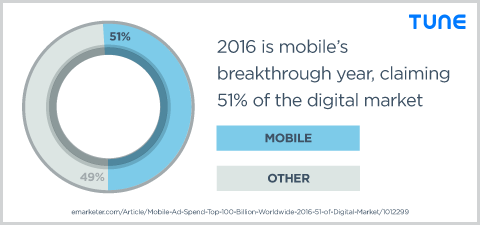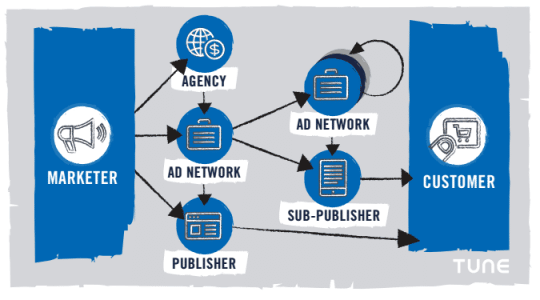This year, users worldwide have spent more than 2.8 of 9.9 hours of their digital media time each day on mobile. That’s equivalent to watching the entire series of Breaking Bad in just over 20 days, or all 10 seasons of Friends in a month!
Nearly everything we do is on the go and nothing is telling us that this trend is slowing down. It’s quite the opposite: According to Gartner, there will be over 2 billion mobile devices in 2016.
I’ve been working in the mobile space since 2009. Since starting at HasOffers by TUNE, leading their sales in Europe, I’ve had the pleasure of visiting my clients all over my region. Some say Europeans are all very different, but when it comes to the conversations I’ve had in 2015, they were very much in sync. Here are my top three hot topics for 2015 and what I see trending next year:
- Mobile Tracking: Do I need an SDK for that?
App developers now understand the mobile ecosystem enough to know that they don’t need to install a network’s SDK to receive their traffic—that was just a way to look for the network to deter them from moving away with the extra resources and costs in switching them out.
The roles were finally reversed and networks had to find a way to run mobile campaigns without additional SDKs to keep track of their conversions. Their options were to build in-house or use a third-party solution.
The amount of conversations I’ve had over espressos, wine, and beers about in-house solutions versus third-party solutions made me slightly light-headed and slur my words. (I swear it’s the complexity of the subject matter, and not the alcohol!) But one thing that I do remember was that for the very few who did opt for their own solution, I always recommended they ask themselves “Will it cause me to deviate from my main business? Could the amount of time and resources to build it be better spent elsewhere? Will I struggle to have all of the features I need to analyze and optimize in real-time?” If the answer to one or more of these questions is “yes”, then the short-term solution of trying to build in-house could prevent you from scaling your business.
When looking for a third-party solution for your mobile tracking, mobile apps, or mobile Web, it’s important to find a provider that moves away from the traditional pixel-based tracking we’re used to seeing on desktop.
Why?
Pixel tracking relies on placing a cookie on the user’s browser and when the conversion occurs, the pixel will look to collect information from the cookie. The problem with the pixel tracking method is that users have the ability to delete their history, not accept the website’s cookie terms and conditions, and some browsers even have private or incognito mode, which have their own tracking prevention built-in. These pixel tracking issues are even more prominent on mobile. Similar to private browsing or incognito mode, mobile browsers are notorious for blocking or deleting cookies. Pixel tracking for apps is just incredibly messy and a total fail on the UX side.
The best form of tracking is server postback, as it’s the most reliable and accurate. This is also what HasOffers by TUNE recommends to their clients for mobile tracking. Sam Armour from BluePod Media told me they have “seen an uplift in conversions of between 15-20% just from using a more reliable tracking solution.”
Also known as postback tracking, server-side tracking, or server-to-server tracking (S2S) tracking. It’s a more reliable form of tracking that doesn’t rely on any cookies being dropped on the user’s browser—a postback URL is fired from a Web server directly.
- Business Models: Look beyond the install

With thousands of ad partners out there and without industry standards, it’s difficult to know which of these ad partners would be best to work with, especially if they all agree to work on their cost per install (CPI). TUNE developed a list of mobile marketing best practices for integrated advertising partners to adhere to. It provides marketers the visibility into which advertising partners support mobile marketing best practices, enabling them to make informed decisions and achieve their marketing goals. It’s called the Certified Partner Program.
With install costs continuously rising, advertisers are forced to compete for the best quality users in order to meet their ROI targets. Ad partners are now comfortable with offering cost per install (CPI) as a business model. I always suggest that my clients come out of their comfort zones and look beyond the install as a way of understanding their clients’ needs more.
There’s estimated to be around 180 billion apps downloaded from app stores worldwide in 2015 and over 167 billion of those apps are free to download. For most mobile advertisers, the install is yet another stage in the sales funnel. It might be closer to their objective than an impression or click, therefore worth more, but it’s still no guarantee that an install will drive an engaged user that will achieve their objective (like an in-app purchase). Being as transparent as possible with your partners shows commitment and helps you stand out from your competition.
A third-party solution can provide ad partners the flexibility to offer any mobile business model they please, not just CPA or CPI. This means the third-party solution needs to be able to track and collect post-install data, including the in-app purchases to work on cost per sale (CPS) models.
Having the ability to create end points for any goal that you or your advertiser are looking to achieve from an app install, in-app or mobile web purchase, are therefore essential.
I mentioned transparency, and it is key to achieving a successful mobile campaign. In order to provide transparency, you need data. In order to collect data, you need a tracking solution that can collect, measure, and pass as many mobile data points as possible upon both click and conversion. Why? The further down the funnel you go, the bigger the cost risk you put upon yourself, rather than your client—they appreciate that. If you have all the conversion points along the way, you can optimize your campaigns to achieve better conversion rates and increase your return on investment (ROI).
- Mobile Optimization: Data, data data
When speaking to companies this year it was quite common to hear that they’re using a system that only provides them with a click ID, which relates to the offer and the publisher. They didn’t have access to see statistical data about their conversion rates from click to action or any additional touch points they want to track leading up to that conversion, nor did they any receive device data.
Optimizing campaigns is essential in order to increase performance. The difference between one ad partner’s ability to drive better results can come from the ability to analyze data. It sounds obvious, but the more data collected, the deeper the ability to analyze and optimize to increase performance, leading to a better ROI.
My most successful clients are utilizing all of the above to make sure they’re running successful mobile marketing campaigns for their clients. The main things to think about are:
- Use a reliable mobile tracking protocol — This is essential to reduce discrepancies and get paid out on all your conversions.
- Be flexible with your business models — understand your client’s objective and think beyond the install.
- Collect as much data as possible — This will help you to optimize and increase performance. ROI is the name of the game!
Like this article? Sign up for our blog digest emails.
Author
Becky is the Senior Content Marketing Manager at TUNE. Before TUNE, she handled content strategy and marketing communications at several tech startups in the Bay Area. Becky received her bachelor's degree in English from Wake Forest University. After a decade in San Francisco and Seattle, she has returned home to Charleston, SC, where you can find her strolling through Hampton Park with her pup and enjoying the simple things in life.





Leave a Reply
You must be logged in to post a comment.